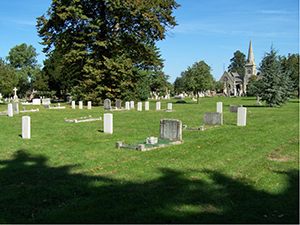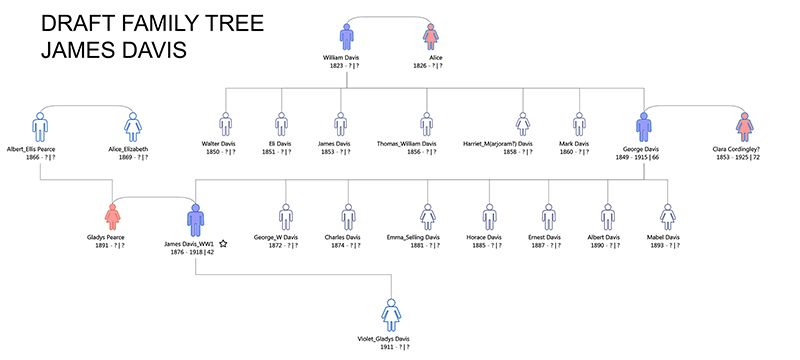First World War Project
James DAVIS (of Doddington)
bapt. 5th August 1877 Private, Service Number 120795 |

James was the third child of local couple George and Clara (née Cordingley) who raised their family initially in Doddington and latterly in Frinsted before returning separately to Doddington. James's older siblings were George and Charles, his younger siblings were Emma Selling, Horace, Ernest, Albert and Mabel.
However, part of this family's story is tied up with separation from their father (George) at least once. Curiously, even when finally separated from Clara, George did not go very far afield as he turns up in the 1911 Census with his brother Eli living in the home of their elderly mother Alice Davis in Doddington. Both George and Eli are recorded as agricultural labourers and both are "married" (but neither of them have wives at the address). The initial separation from George was picked up in newspapers of the time.
| Thanet Advertiser of 1st March 1884 |
| DODDINGTON. WIFE DESERTION. At the Faversham County Petty Sessions on Thursday, before R.J. Hilton, Esq., and Captain Hooper, George Davis, labourer, of Doddington, was brought up under a warrant charged with neglecting to maintain his wife and five children, whereby they had become chargeable to the common fund of the Faversham Union. Prisoner said his master (Mr. F.B. Cobb) have him notice to leave, and he went in search of work. Mr. Allen Tassell, clerk to the Guardians, informed the magistrates that Mr. Cobb gave the prisoner a week's notice to quit the cottage he occupied, but not to leave his employ. Fourteen days' hard labour. |
After the 1881 Census, Clara had four more children registered in Frinsted. The change in the family home and four additions to the family may suggest that Clara and George were reconciled for a period. Whatever the case, their relationship broke down again as, by 1911, George was living in his mother's home in Doddington, while Clara is living separately as a laundress, also in Doddington. By 1911, all their children had moved on.
Against this uncertain upbringing, James remained an agricultural labourer until war broke out and he immediately volunteered in August 1914 (calculated from a significant War Gratuity). His wife, Gladys, was named the sole beneficiary for War Gratuity of £23 10s. and personal effects of £35 14s. 10d. [See Appendix 2]
Military Experience
We know James enlisted at Cranbrook. This decision is explained by the 1911 Census that places James, his wife and young child (Violet Gladys) with Gladys's parents - Albert Ellis and Alice Elizabeth Pearce at Iden Green, Goudhurst - five miles from Cranbrook. James enlisted, Private, 10140, 3rd (Reserve) Battalion East Kent Regiment (The Buffs). In 1914, his age of 38 years was the maximum age allowable to enlist for active service overseas. It may also be that his age and a life of manual labour explains his service outside trench warfare.
James was awarded the 14-Star that is reserved for those serving overseas between 4th August and 22 November 1914. His Medal Card confirms that he entered 'the Theatre' on 9th November 1914. That card omits anything more specific to help us place the theatre in which he served. The "S" prefix on the medal card suggests he was recruited into "General service" and, in the Army Service Corps, that prefix applied to the "Supply" function. The medal record, confirms that James eventually transferred into the Army Service Corps, transferred into the 302nd Company of the Labour Corp. He was serving in that unit up to the time of death in Croydon Hospital.
1917 - 2nd Battalion The Buffs Hospital Records
A transcription by Forces War Records of a 1917 hospital record for "James Davis, 10140, 2nd Battalion, The Buffs" gives us possible avenues to explore.
At the outbreak of war, the 2nd Battalion, was stationed at Wellington, Madras. On 16th November, the Battalion departed for Plymouth from Bombay and then moved to Winchester to join the 85th Brigade of the 28th Division. The Battalion mobilised on 17th January 1915.
 This record states that James was "attached to 22nd Kite Balloon Section." In which case, his early mobilisation may have made sense in preparing him to support this important aid to field observation and photography/mapping. A Kite Balloon resembles the classic "sausage shape" with inflated ''fins" at the rear. This aerodynamic element makes sense when you understand that a "kite balloon" was launched while attached to a tractor unit - this tractor would move the observation platform up and down the line, keeping the balloon aligned. So, as part of the Army Service Corp, James may have been involved in launching and driving/moving the platform that was highly vulnerable to aeroplane attack - observers/photographers where supplied with parachutes. The same device was used at sea to keep an eye out for enemy submarines and ships.
This record states that James was "attached to 22nd Kite Balloon Section." In which case, his early mobilisation may have made sense in preparing him to support this important aid to field observation and photography/mapping. A Kite Balloon resembles the classic "sausage shape" with inflated ''fins" at the rear. This aerodynamic element makes sense when you understand that a "kite balloon" was launched while attached to a tractor unit - this tractor would move the observation platform up and down the line, keeping the balloon aligned. So, as part of the Army Service Corp, James may have been involved in launching and driving/moving the platform that was highly vulnerable to aeroplane attack - observers/photographers where supplied with parachutes. The same device was used at sea to keep an eye out for enemy submarines and ships.
We can only speculate that James was initially placed in the supply depot in France before being allocated to the 2nd Battalion Kite Balloon Section. This 'staged' approach to postings was common-place. Perhaps, nominally, he was mobilised with the 1st Battalion depot? Whether this is right or not, it can be speculated that on or after 17th January 1915, he joined the Supply Train of the 2nd Battalion as it moved up to take part in the Second Battle of Ypres and the battle of Loos before embarking for the Macedonian Theatre against the Bulgarian forces.
In 1916, the 2nd Battalion was involved in the occupation of Mazirko and the capture of Barakli Jum'a. This brings us to 1917, when James was hospitalised in the capture of Ferdie and Essex Trenches (near Barakli Jum'a) and the capture of Barakli and Kumli (16th October 1917). This record also tells us that James was attached to 22nd Kite Balloon Section. The medical record tells us he was admitted on 28th October 1917 with undiagnosed "pyrexia (fever) - Malaria, benign tertiary". Benign Tertian Malaria is characterised by fevers every three days. If properly diagnosed, this was probably malaria contracted through one of the less lethal parasites. Nevertheless, James was transferred to sick convoy on 30th October and spent some time in No. 21 Stationary Hospital, situated close to Sarigol Military Cemetery, Kriston, Greece.
Circumstances of the death of James Davis
The Soldier's Effects record for James moves the story forward to the "3rd Division, War Hospital, Croydon."
The book "Croydon in the Great War", edited by Alderman H. KEATLEY MOORE unwraps his position to some degree. On the face of it, "3rd Division" refers to one of five school sites commandeered in and around Croydon - in this case, Ingram Road School, Thornton Heath, Surrey. This site had 165 beds for recovering patients receiving guided exercise programmes. This book explains that the "total number of patients admitted was 19,182, of whom 4,153 were discharged as invalids. The number of deaths was 196, and of these 79 occurred during the influenza epidemics of 1918. Thus, excluding the influenza epidemics, the mortality was under 1 per cent." Part of this good record may lie in the kind of cases they handled.
Croydon Division War Hospital appears mostly to be employed with broken bones and reconstruction and recuperation. Although these lines became blurred in times of highest pressure. While we are unable to pin down the cause of James's death, a likely candidate is the Spanish flu (perhaps made worse by a weakened immune system from persistent malaria)?
The tragedy of the Spanish influenza epidemic (1918-20) is that it claimed between 3 and 5 percent of the global population giving deaths as between 50 and 100 million souls (estimates are very rough).
The impact of Spanish Flu became progressively worse in and around towns and cities at the time of James' death.
The Acceleration of Deaths from Influenza in October 1918
| The Daily Mirror of 31st October 1918 |
1,256 'FLU' DEATHS IN LONDON LAST WEEK. Four Weeks Ago There Were Only Seventeen. CAMP OUTBREAKS. Startling figures as to the deaths resulting from influenza are given in the Registrar-General's report last night. EXTRA FOOD APPEALS. |
James Davis was posthumously awarded the 14 Star, British War and Victory Medals. [See Appendix 1]


 World War 1 Pages
World War 1 Pages